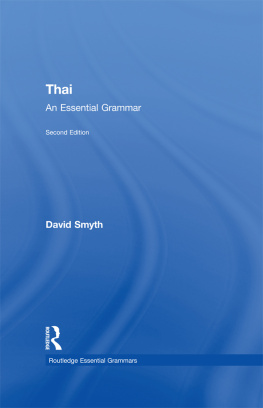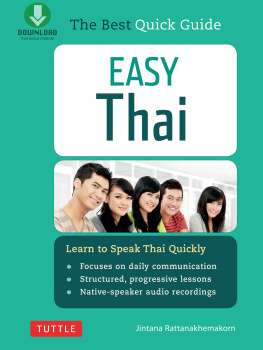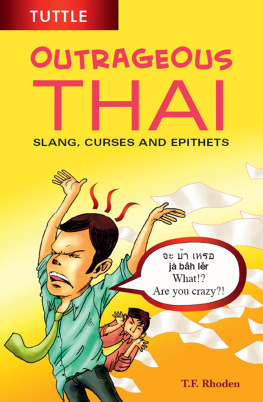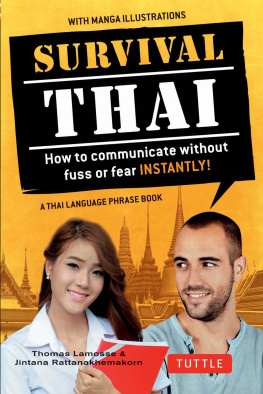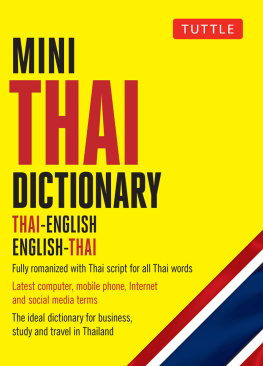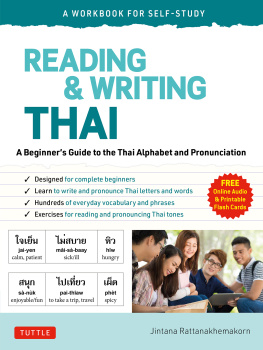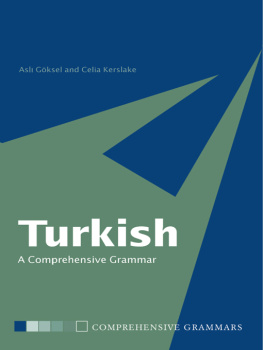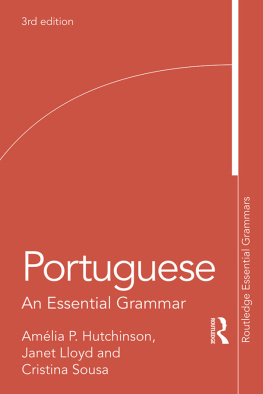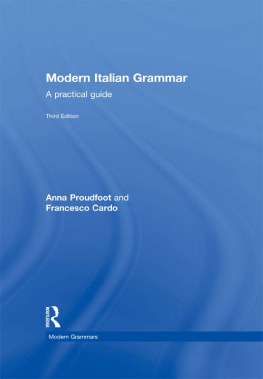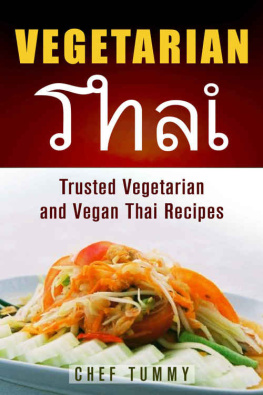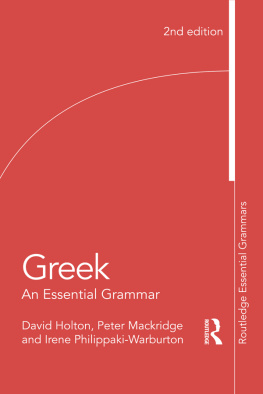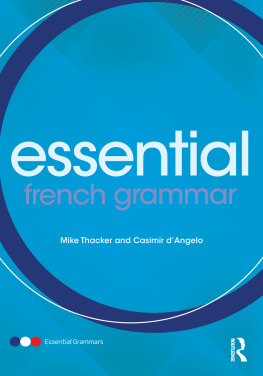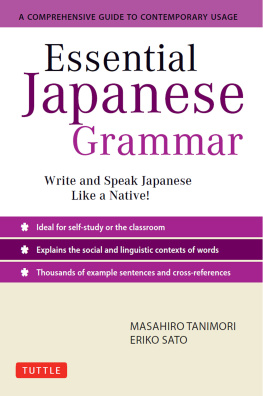Thai
An Essential Grammar
2nd edition
This second edition of Thai: An Essential Grammar provides an up-to-date and concise reference guide to Thai grammar.
Using clear, jargon-free explanations, it sets out the complexities of Thai in short, readable sections and presents an accessible description of the language. Focus is kept on the real patterns of use today and grammar forms are demonstrated through a wide range of relevant examples. No prior knowledge is assumed on the part of the reader.
Features include:
coverage of crucial topics, such as sentence particles, negation, questions and quantification
examples given in both Thai script and romanised transliteration
pronunciation section
guidance on speech conventions and the Thai writing system
glossary of grammatical terms
two appendices covering romanisation systems and three key verbs
bibliography
This unique reference work will prove invaluable to all learners looking to master the grammar of Thai. It is ideal for both independent study and for students in schools, colleges, universities and adult classes of all types.
David Smyth is Senior Lecturer in Thai at the School of Oriental and African Studies, University of London.
Routledge Essential Grammars
Essential Grammars are available for the following languages:
Arabic
Chinese
Czech
Danish
Dutch
English
Finnish
Modern Hebrew
German
Greek
Hindi
Hungarian
Korean
Latvian
Norwegian
Polish
Portuguese
Romanian
Serbian
Spanish
Swedish
Thai
Turkish
Urdu
Thai
An Essential Grammar
2nd edition
 | David Smyth |

Second edition published 2014
by Routledge
2 Park Square, Milton Park, Abingdon, Oxon OX14 4RN
and by Routledge
711 Third Avenue, New York, NY 10017
Routledge is an imprint of the Taylor & Francis Group, an informa business
2014 David Smyth
The right of David Smyth to be identified as author of this work has been asserted by him in accordance with sections 77 and 78 of the Copyright, Designs and Patents Act 1988.
All rights reserved. No part of this book may be reprinted or reproduced or utilised in any form or by any electronic, mechanical, or other means, now known or hereafter invented, including photocopying and recording, or in any information storage or retrieval system, without permission in writing from the publishers.
Trademark notice: Product or corporate names may be trademarks or registered trademarks, and are used only for identification and explanation without intent to infringe.
First edition published by Routledge 2002
British Library Cataloguing in Publication Data
A catalogue record for this book is available from the British Library
Library of Congress Cataloging in Publication Data
Smyth, David, 1954 author.
Thai : an essential grammar / David Smyth. Second edition.
pages cm. (Routledge essential grammars)
Includes bibliographical references and index.
1. Thai languageGrammar. I. Title.
PL4163.S64 2013
495.918242 1dc23
2013019254
ISBN: 978-0-415-51033-2 (hbk)
ISBN: 978-0-415-51034-9 (pbk)
ISBN: 978-1-315-87105-9 (ebk)
Typeset in Sabon and Gill Sans
by Graphicraft Limited, Hong Kong
Contents
The aim of the first edition of this book was to provide a description of the main features of Thai grammar which would be accessible to the ordinary learner with little or no knowledge of linguistic terminology.
This second edition differs only slightly in content from the first edition. The major difference is cosmetic: examples are given in Thai script first, while the Mary Haas-based phonemic system of romanising Thai has been abandoned in favour of a less-technical system. In addition, some new examples have been included, some explanations simplified and some errors eliminated.
I am grateful to those people who have written messages of appreciation for the first edition and offered suggestions and advice on how it might be improved. I am indebted to Routledges anonymous reviewers of the first edition for their valuable suggestions and encouraging comments. I am especially grateful to Sujinda Khantayalongkoch and Vantana Cornwell for sharing their insights on the language, often at great length, and for checking the Thai entries. Errors, omissions and other shortcomings that may remain are, however, entirely my own responsibility.
Thai (formerly called Siamese) is a member of the Tai family of languages, which are spoken by an estimated 70 million people dispersed over a wide area of Asia, from northern Vietnam to northern India. Thai, with over 50 million first-language speakers, is the most important language in the Tai family, which also includes Lao, Shan (spoken in northern Burma) and some 15 million speakers in south-western China. Despite common structural features, even closely-related Tai languages are often mutually unintelligible because of phonological and lexical differences. Tai speakers were once thought to have originated from China and migrated southwards, but today, the border area between northern Vietnam and Chinas Guangxi province is regarded as a more likely origin. From the eighth century AD Tai speakers began to migrate westwards and south-westwards into what is present-day Thailand.
Thai is the national language of Thailand. Distinct regional dialects of Thai are spoken in the north, north-east and south of the country, but the language of the Central Region is regarded as the standard and is used both in schools and for official purposes throughout the country.
Thai is a tonal language, with the meaning of each syllable determined by the pitch at which it is pronounced. Standard Thai has five tones mid, low, high, rising and falling. Thai has no noun or verb inflections: a noun has a single form, with no distinction between singular and plural, while past, present and future time can be conveyed by a single verb form. Like many other South-East Asian languages, Thai has a complex pronoun system, which reflects gender, age, social status, the formality of the situation and the degree of intimacy between speakers. Much of the original Thai lexicon is monosyllabic; a high percentage of polysyllabic words are foreign borrowings, particularly from the classical Indian languages, Sanskrit and Pali.
There are many ways of romanising Thai but no universally recognised system. Academic linguists use one system, librarians another, the Royal Thai Institute yet another, while writers of textbooks, phrasebooks and dictionaries often adapt or devise their own personal systems. Thais can neither systematically write their language in the Western alphabet nor easily read Westerners romanisations of Thai; the average Thai, when called upon to romanise Thai words, will almost certainly do so in a quite unsystematic way.
Some romanisation systems use special phonetic symbols to represent the sounds of Thai more precisely and accents to represent tones and vowel length, while other less-precise systems use a near equivalent in the authors own language which may confuse learners who do not share the authors mother tongue or even just his regional dialect. The complexities and ambiguities of romanised Thai can be bypassed by learning to read the Thai script.
Next page
